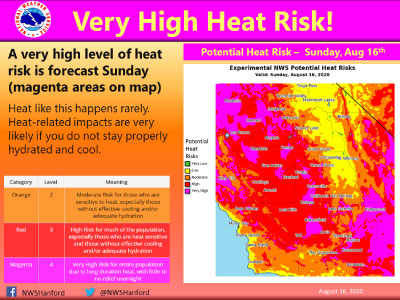FOLSOM — The California Independent System Operator (ISO) issued a statewide Flex Alert, a call for voluntary electricity conservation, beginning today and extending through Wednesday. The Flex Alerts are in effect from 3 p.m. to 10 p.m. each day.
A persistent, record-breaking heat wave in California and the western states is causing a strain on supplies, and consumers should be prepared for likely rolling outages during the late afternoons and early evenings through Wednesday. There is not a sufficient amount of energy to meet the high amounts of demand during the heatwave.
However, consumers can actively help by shifting energy use to morning and nighttime hours and conserving as much energy as possible during the late afternoon and evening hours. Consumer conservation can help lower demand and avoid further actions including outages, and lessen the duration of an outage.
Consumers are urged to lower energy use during the most critical time of the day: 3 p.m. to 10 p.m., when temperatures remain high and solar production is falling due to the sun setting.
Extended periods of heat also can cause generator equipment failures that can lead to more serious unplanned losses of power.
The ISO recognizes that reducing energy use during the hot time of the day is a
hardship, especially for those working from home or with children schooling at home. However, if a large number of consumers do their part in small ways, conservation can make a difference.
Between 3 p.m. and 10 p.m., the ISO is urging consumers to:
- Set air conditioning thermostats to 78 degrees, if health permits
- Defer use of major appliances
- Turn off unnecessary lights
- Unplug unused electrical devices
- Close blinds and drapes
- Use fans when possible
Consumers can also take steps to prepare for the Flex Alert by doing the following
before 3 p.m.:
- “Pre-cool” their homes, or lower air conditioning thermostats to 72 degrees
- Charge electric vehicles
- Charge mobile devices and laptops
- Run dishwashers, washing machines and other major appliances
- Set pool pumps to run in the early morning or late at night
For information on Flex Alerts, and to get more electricity conservation tips, visit the ISO’s Flex Alert website.
Some commonly asked questions include:
How will I know if my power will go out?
All PG&E customers with current contact information on file were notified Monday by call, email and text to alert them to the possibility of rotating outages.
If rotating outages are needed, PG&E will post information at this page to show the order in which PG&E will likely proceed, if ordered by California Independent System Operator (CAISO) to turn off power. Estimated restoration times are 2-3 hours after the outage actually starts. The situation remains dynamic and shutoff times may change. Check back at this page frequently for updates.
Look up your block info at https://www.arcgis.com/apps/instant/lookup/index.html?appid=04b7c901f2ff468daed74df54396d75e.
How are rotating outages different from Public Safety Power Shutoffs (PSPS?)
Public Safety Power Safety (PSPS) events are called during specific high fire-threat conditions. Rotating outages are due to strain on California’s grid. The need for outages is determined by the statewide grid operator and not PG&E. Rotating outages are not related to any issues with PG&E’s equipment or its ability to deliver energy locally.
PG&E does not anticipate initiating any Public Safety Power Shutoff events this week. Any power outages that occur during this hot spell are not PSPS events. To learn more about PSPS events, visit www.pge.com/psps.
What is a CAISO rotating outage?
Rotating outages (Stage 3 Emergencies) become necessary when the ISO is unable to meet minimum contingency reserve requirements and load interruption is imminent or in progress. These emergencies are declared by the CAISO.
The CAISO oversees the larger power grid and balances energy demand with supply. As the electricity balancing authority, the CAISO is responsible for evaluating forecasting models for both customer demand and generation supply.
CAISO will typically order the state’s utilities, including PG&E, to reduce electrical load by turning off service immediately in order to prevent larger outages on the grid. Due to the emergency nature of these outages, we will not be able to give advance warning to customers.
Should the CAISO declare a Stage 3 emergency that requires the use of rotating outages, PG&E will first reduce load to specific groups of customers. Then, if additional reduction in load is needed, PG&E will turn off power to groups of customers according to their rotating outage block number.
These are called rotating block outages. These outages help alleviate grid capacity and power generation issues by rotating sets of customers through a temporary outage during different times until the rotating outages are no longer needed.
To learn more about rotating outages, visit their Frequently Asked Questions page.
For questions about the lookup tool results and shutoff times, please click here.




